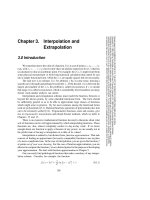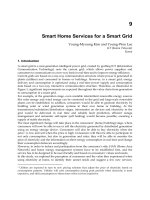Chapter 012. Pain: Pathophysiology and Management (Part 1) pptx
Bạn đang xem bản rút gọn của tài liệu. Xem và tải ngay bản đầy đủ của tài liệu tại đây (753.23 KB, 5 trang )
Chapter 012. Pain:
Pathophysiology and Management
(Part 1)
Harrison's Internal Medicine > Chapter 12. Pain: Pathophysiology and
Management
Pain: Pathophysiology and Management:
Introduction
The task of medicine is to preserve and restore health and to relieve
suffering. Understanding pain is essential to both these goals. Because pain is
universally understood as a signal of disease, it is the most common symptom that
brings a patient to a physician's attention. The function of the pain sensory system
is to protect the body and maintain homeostasis. It does this by detecting,
localizing, and identifying tissue-damaging processes. Since different diseases
produce characteristic patterns of tissue damage, the quality, time course, and
location of a patient's pain complaint and the location of tenderness provide
important diagnostic clues and are used to evaluate the response to treatment.
Once this information is obtained, it is the obligation of the physician to provide
rapid and effective pain relief.
The Pain Sensory System
Pain is an unpleasant sensation localized to a part of the body. It is often
described in terms of a penetrating or tissue-destructive process (e.g., stabbing,
burning, twisting, tearing, squeezing) and/or of a bodily or emotional reaction
(e.g., terrifying, nauseating, sickening). Furthermore, any pain of moderate or
higher intensity is accompanied by anxiety and the urge to escape or terminate the
feeling. These properties illustrate the duality of pain: it is both sensation and
emotion. When acute, pain is characteristically associated with behavioral arousal
and a stress response consisting of increased blood pressure, heart rate, pupil
diameter, and plasma cortisol levels. In addition, local muscle contraction (e.g.,
limb flexion, abdominal wall rigidity) is often present.
Peripheral Mechanisms
The Primary Afferent Nociceptor
A peripheral nerve consists of the axons of three different types of neurons:
primary sensory afferents, motor neurons, and sympathetic postganglionic neurons
(Fig. 12-1). The cell bodies of primary sensory afferents are located in the dorsal
root ganglia in the vertebral foramina. The primary afferent axon bifurcates to
send one process into the spinal cord and the other to innervate tissues. Primary
afferents are classified by their diameter, degree of myelination, and conduction
velocity. The largest-diameter fibers, A-beta (Aβ), respond maximally to light
touch and/or moving stimuli; they are present primarily in nerves that innervate
the skin. In normal individuals, the activity of these fibers does not produce pain.
There are two other classes of primary afferents: the small-diameter myelinated A-
delta (Aδ) and the unmyelinated (C fiber) axons (Fig. 12-1). These fibers are
present in nerves to the skin and to deep somatic and visceral structures. Some
tissues, such as the cornea, are innervated only by Aδ and C afferents. Most Aδ
and C afferents respond maximally only to intense (painful) stimuli and produce
the subjective experience of pain when they are electrically stimulated; this
defines them as primary afferent nociceptors (pain receptors). The ability to detect
painful stimuli is completely abolished when Aδ and C axons are
blocked.
Components of a typical cutaneous nerve.
There are two distinct functional categories of axons: primary afferents
with cell bodies in the dorsal root ganglion, and sympathetic postganglionic fibers
with cell bodies in the sympathetic ganglion. Primary afferents include those with
large-diameter myelinated (Aβ), small-diameter myelinated (Aδ), and
unmyelinated (C) axons. All sympathetic postganglionic fibers are
unmyelinated.Individual primary afferent nociceptors can respond to several
different types of noxious stimuli. For example, most nociceptors respond to
heating, intense cold, intense mechanical stimuli such as a pinch, and application
of irritating chemicals including ATP, serotonin, bradykinin and histamine.









